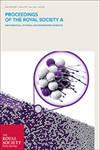利用方程学习将粗粒度模型推向连续极限
IF 3
3区 综合性期刊
Q1 MULTIDISCIPLINARY SCIENCES
Proceedings of the Royal Society A: Mathematical, Physical and Engineering Sciences
Pub Date : 2024-01-10
DOI:10.1098/rspa.2023.0619
引用次数: 0
摘要
建立生物种群动态数学模型通常需要提出基于离散代理的高保真模型,以捕捉随机性和个体水平的过程。这些模型通常与仅捕捉种群水平特征的近似粗粒度微分方程一起考虑。这些粗粒度模型只有在某些渐近参数情况下才是准确的,例如强制要求个体运动的时间尺度远远超过出生/死亡过程的时间尺度。当这些粗粒度模型准确时,离散模型在微观层面仍遵守守恒定律,这意味着存在某种宏观守恒定律可以描述宏观动力学。在这项工作中,我们引入了一个方程学习框架,以便在标准连续极限方法不准确时找到准确的粗粒度模型。我们使用上皮组织的离散机械模型来演示我们的方法,考虑了一系列四个案例研究,包括有自由边界和无自由边界的问题,以及有增殖和无增殖的问题,说明我们如何学习描述机械弛豫、细胞增殖的宏观方程,以及支配组织自由边界动态的方程。虽然我们的演讲侧重于这一生物应用,但我们的方法更广泛地适用于一系列离散模型近似连续极限描述的场景。本文章由计算机程序翻译,如有差异,请以英文原文为准。
Pushing coarse-grained models beyond the continuum limit using equation learning
Mathematical modelling of biological population dynamics often involves proposing high-fidelity discrete agent-based models that capture stochasticity and individual-level processes. These models are often considered in conjunction with an approximate coarse-grained differential equation that captures population-level features only. These coarse-grained models are only accurate in certain asymptotic parameter regimes, such as enforcing that the time scale of individual motility far exceeds the time scale of birth/death processes. When these coarse-grained models are accurate, the discrete model still abides by conservation laws at the microscopic level, which implies that there is some macroscopic conservation law that can describe the macroscopic dynamics. In this work, we introduce an equation learning framework to find accurate coarse-grained models when standard continuum limit approaches are inaccurate. We demonstrate our approach using a discrete mechanical model of epithelial tissues, considering a series of four case studies that consider problems with and without free boundaries, and with and without proliferation, illustrating how we can learn macroscopic equations describing mechanical relaxation, cell proliferation, and the equation governing the dynamics of the free boundary of the tissue. While our presentation focuses on this biological application, our approach is more broadly applicable across a range of scenarios where discrete models are approximated by approximate continuum-limit descriptions.
求助全文
通过发布文献求助,成功后即可免费获取论文全文。
去求助
来源期刊
CiteScore
6.40
自引率
5.70%
发文量
227
审稿时长
3.0 months
期刊介绍:
Proceedings A has an illustrious history of publishing pioneering and influential research articles across the entire range of the physical and mathematical sciences. These have included Maxwell"s electromagnetic theory, the Braggs" first account of X-ray crystallography, Dirac"s relativistic theory of the electron, and Watson and Crick"s detailed description of the structure of DNA.

 求助内容:
求助内容: 应助结果提醒方式:
应助结果提醒方式:


